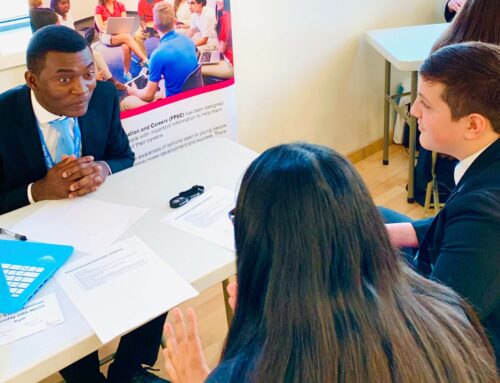And so, the end of our series is near – but is the same fate in store for the CV? In our previous three articles in this series, we explored the origins of the CV and the importance of a personalised approach. We followed this by discussing some of the unique alternative CV mediums that jobseekers employ to stand out, and then branched out into new territory with an introduction to the growing practice of Video CVs. Our final article examines what could be the long-term future of the CV and how we articulate ourselves as professionals moving forward. Here, we take a look at the use of digital employability portfolios like LinkedIn, globalbridge and Handshake, and how these platforms are creating a different approach to recruitment for both employers and jobseekers alike.

Are you LinkedIn? Accessing the ‘Hidden Job Market’
Depending on what articles you read, you can find survey data suggesting that the ‘Hidden Job Market’ (i.e. jobs found through sources other than job postings such as via social media or through existing networks) accounts for anything from 50% of all vacancies to as high as 75-95% of all jobs filled. While it is advisable to take any of these impossible-to-verify figures with a liberal pinch of salt, most of us are acutely aware of the power of networks in the process of job hunting, whether it is being signposted to an as-yet-unadvertised role by a colleague in the know or being connected to the right individual in a company’s HR department via a contact on LinkedIn. Indeed, this is where digital portfolios like LinkedIn potentially have an advantage over CVs, in that they not only provide a template for recording key personal details like your employment history, education and extra-curricular achievements, but also allow individuals to connect and talk with myriad professionals in what is akin to a never-ending networking event.
Given the benefits of accessing the Hidden Job Market and the number of young people of working age identifying as social media users, it would seem as though digital portfolios like LinkedIn are a ready-made CV replacement for the next generation. However, despite the prevalence of social media and the various online articles and thought pieces extolling the virtues of using LinkedIn to jobseekers and students, many of the clients who we work with as careers practitioners inform us that they are daunted by the prospect of setting up a LinkedIn profile and reaching out to professionals. This seems to be particularly acute with students, who often identify LinkedIn as a ‘network for people who already have a network’ and express that they do not feel they have the relevant professional experience to be confident using the platform. In the wake of this type of feedback, different digital portfolio platforms such as globalbridge and Handshake have emerged, offering students, jobseekers and employers a new way to connect outside of both LinkedIn and the traditional CV/application form.
Joining the dots – helping employers ‘find the blue squirrel’
Platforms like Handshake and globalbridge have created online portfolio environments that replicate the interactive, networking-based nature of LinkedIn within a framework that is more student-focused. The people behind these platforms believe that technology is key to tackling both student employability and challenges with recruitment. Clare Adams, University Partnerships Manager at Handshake, notes; “Web 2.0 changed the world wide web, from a one-way conversation to an interactive experience within a virtual community filled with profiles and networks. As with traditional CVs and networks the amount of value that students and employers can gain from these digital alternatives varies based on many of the same enablers and barriers. In the case of students these could include personal networks, mentors, access to advice, digital skills, communications skills and opportunity awareness, while for employers there could be budget, awareness, regional and resourcing challenges to overcome.” Clare feels that as Handshake allows students, employers, universities and careers professionals to all have interactive profiles on the same network, this can potentially help student recruitment and digital careers advice evolve from a “…one-way (often siloed and reactive) conversation to an interactive, proactive and collaborative experience for all, allowing students and employers to benefit more equally from the ‘network effect’, student careers and recruitment 2.0”.
Ben Brownlee, Product Manager at globalbridge, agrees that digital portfolios offer mutual benefits to both employers and jobseekers – “We hear many employers say that viewing a globalbridge profile makes their decision easier in the hiring process, as they are able to get a better idea of whether the individual in question would be a good cultural fit for their organisation” – something that Ben explains he and his team have sometimes heard referred to as ‘finding the blue squirrel‘! This approach not only has the potential to make life more straightforward for employers/recruiters but also jobseekers themselves, as it can help individuals identify early on in the application process whether they are a good fit for the company and job role, and promote the importance of researching an organisation before submitting an application.
More than just a work history – helping jobseekers shout about themselves
Another key difference between digital portfolios and the traditional CV is how much information can be gained about a prospective candidate. As Ben Brownlee from globalbridge notes, “A CV doesn’t always provide a full impression of what the person is like…digital portfolios not only allow individuals to better express their personality but also help them to validate the information that is traditionally on a CV by providing a platform to add media such as photographs, videos or testimonials”. This approach could help jobseekers feel that they are leaving less to chance than when they submit a typical CV. Indeed, many jobseekers – particularly students – anecdotally identify the difficulty of distilling what they have done in two pages or less, especially if they have no industry experience to speak of. So knowing how to effectively curate a digital portfolio and decide what to emphasise or leave out is certainly easier said than done, and another area where the support of careers practitioners at all levels of education is critical.
In an era where our online identities, both professional and personal, have never been more on display than they are now, it is hard to imagine a LinkedIn, globalbridge or Handshake account not being a key part of a jobseeker’s armoury in the near future. As a former post-16 teacher, Ben Brownlee believes these are an overwhelmingly positive development – “We see digital portfolios like the ones globalbridge users create as a modern version of the old school National Record of Achievement – it is an opportunity for students to acknowledge and celebrate that they are more than just a list of grades but the product of all of the achievements in their life, both academic and extra-curricular”.
Dr. Jamie Mackay, Employment Expert with MAKEMEAVIDEOCV, feels that LinkedIn is also starting to offer additional opportunities for jobseekers to shout about their skills and achievements – “LinkedIn have recently started offering Skills Quiz’ with the option to add a badge to your profile – this is a nice touch that may appeal to a wider demographic using the platform and a really neat way to show off your knowledge and skills!”
Evolution or Revolution? Where next for the CV?
So as we reach the culmination of this series of articles on the humble CV, what conclusions can we draw regarding the future of the CV as a job seeking tool? Although it might be tempting to herald the growth of digital portfolio platforms like LinkedIn, globalbridge and Handshake as a sea change in the way that employers recruit, even the most ardent supporters of these mediums acknowledge that we have a long way to go until simply sharing a LinkedIn URL becomes the new normal in relation to job applications. That said, the foundations are clearly being laid for a steady evolution of the CV as employers seek more innovative and proactive ways to locate, recruit and retain not only the best talent, but the best fit for their business. For now, this may not be commonplace but if the success of Handshake in the US graduate labour market has demonstrated anything, it is that both employers and jobseekers have an appetite for connecting in new and innovative ways.
Whatever the long-term fate of the CV, the emergence of new CV mediums and alternative approaches like Video CVs and digital portfolios suggest that, much like the CV itself, jobseekers should always be prepared to adopt a personalised and flexible strategy when submitting applications and articulating their professional identity to employers and recruiters. If our research and conversations with employers and careers practitioners for these articles have demonstrated one simple and salient point, it is that content is king and that a well-written, targeted and unique CV is worth its weight in gold. We are hoping these articles have stimulated further discussion on the subject of CVs, so please feel free to contact us on LinkedIn or post your comments below the article to share your thoughts on the subject!
CONTRIBUTORS
Clare Adams – University Partnerships Manager at Handshake, an online career management, student recruitment and professional networking community for students, employers, recruiters and careers professionals. Since launching in the US in 2014, the Handshake network has grown to include 17M students and alumni, 500K employers, 900+ universities and 12,000+ careers professionals in the US. Handshake will launch in the UK in the summer of 2020. Prior to joining Handshake, Clare worked in a variety of roles across careers and student services in HE and FE.
Ben Brownlee – Product Manager at Globalbridge, an online EdTech platform that connects young people and educators with employers and future opportunities. Globalbridge work with schools, colleges, universities and employers across the country, as well as being a lead sponsor for National Careers Week 2020.
Chris is a registered career development professional and member of the Career Development Institute (CDI) and Association of Graduate Careers Advisory Services (AGCAS).
Jamie is an employment expert with MAKEMEAVIDEOCV and a Skills Strategy Manager with the Enterprise M3 Local Enterprise Partnership.





